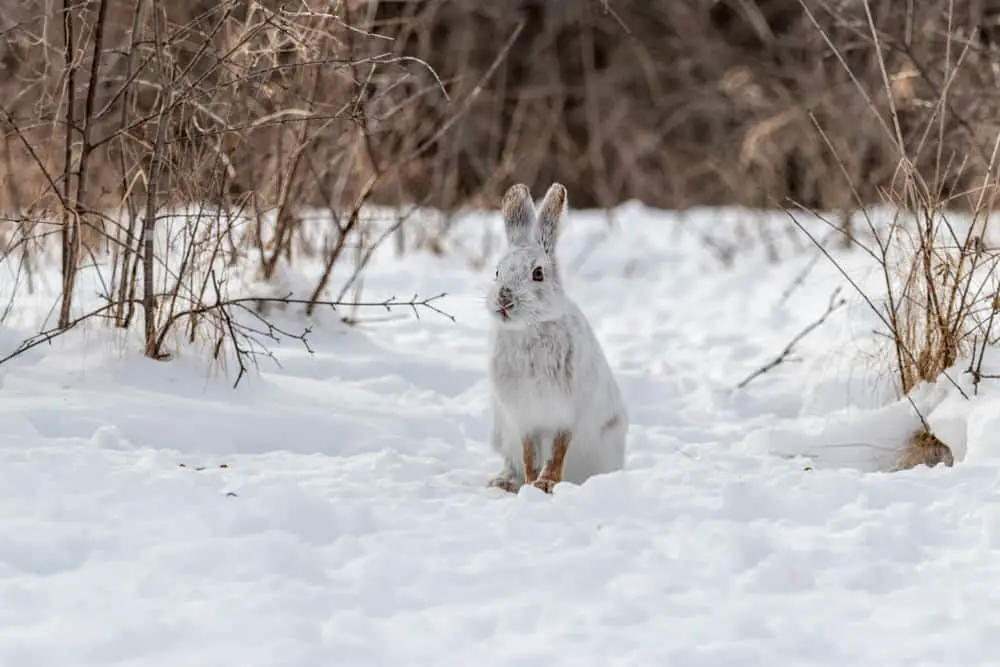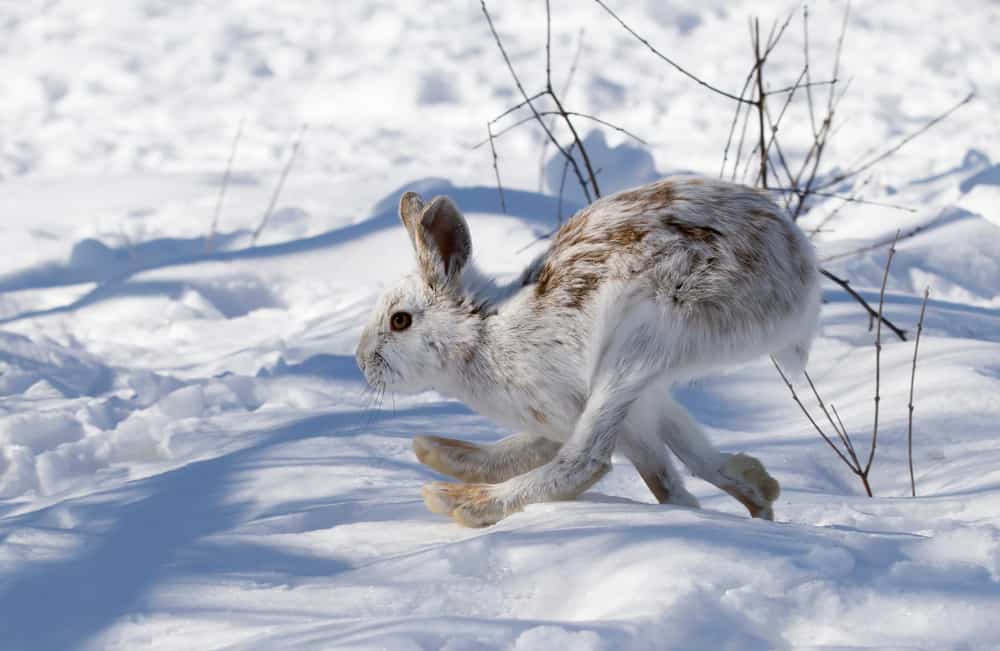Snowshoe hares (Lepus americanus) are native to North America and inhabit boreal, subarctic, and alpine forest habitats. The snowshoe hare is well-known for its ability to change the color of its coat from brown in summer to white in winter, providing camouflage from predators during both seasons.
Snowshoe hares also have large hind feet which enable them to move quickly through deep snow that often covers their environment during long winters. Due to their unique adaptations, understanding the ecology of this species is essential for conservation efforts.

Overview
The snowshoe hare (Lepus americanus) is a small mammal species found in the northern forests and arctic tundra of North America. It has large, fur-covered hind feet which act as natural “snowshoes” that enable it to walk through deep snow.
This adaptation enables it to survive in its cold habitat by providing insulation from the freezing temperatures and allowing for mobility over the wintery landscape. The snowshoe hare also differs from other mammals due to its coat color changing from brownish during summer months to white or grayish during winter months, offering further protection against freezing conditions.
This seasonal change in fur color allows it to blend into its environment and camouflage itself from potential predators such as foxes and coyotes. As herbivores, they feed on various types of vegetation including twigs, buds, bark, lichens, fungi, grasses and herbs.
Snowshoe hares are solitary animals with some populations having overlapping home ranges while others may have non-overlapping ranges according to their density levels within an area. In summary, the snowshoe hare is a unique mammalian species adapted for life within their northern forest and arctic tundra habitats where temperature extremes require special adaptations for survival.
Habitat And Range
The snowshoe hare is found in a wide range of habitats and can be located throughout North America. It prefers boreal forest, sub-arctic shrublands, coniferous forests, aspen parkland, fields and wetlands. A large portion of its population resides from Alaska and the Yukon to Newfoundland in Canada down through the northern United States. This species also inhabits some areas further southwards around the Great Lakes region; however they are not native to this area but were introduced by humans during the 19th century.
In terms of elevation, snowshoe hares inhabit both lowland and high mountain regions ranging up to 3200 m above sea level. They prefer environments with dense vegetation such as subalpine meadows or alpine tundra which provide them protection against their predators. Snowshoe hares have been known to occupy agricultural lands when available near wooded areas where they can find food and shelter.
Habitat destruction has posed a serious threat for existing populations of snowshoe hares that live on marginal habitats due to human activities like logging, mining and urban development resulting in fragmentation of these habitats into small patches which makes them more vulnerable to predation.
Diet And Foraging Behavior
The snowshoe hare is a unique species that feeds largely on vegetation. Its diet and foraging behavior are influenced by seasonal changes, with feeding habits shifting from plant to leaf materials as the seasons progress. Studies have shown that the snowshoe hare has an omnivorous diet composed of both plants and insects.
In its natural habitat, the snowshoe hare typically spends much of its day foraging for food in open areas such as meadows or grasslands. During winter months when there is less available foliage, they may also feed on twigs and bark from shrubs and trees. The most common foods eaten include:
- Plant Diet:
- Grasses & Forbs
- Fruits & Berries
- Seeds & Nuts
- Leaf Eating:
- Foliage From Trees & Shrubs
- Herbaceous Plants
- Lichens & Mosses
- Twig Browsing:
- Bark Stripped From Tree Branches
- Buds Of Flowering Shrubs
- Needles From Coniferous Trees
Snowshoe hares can be seen eating these items during any season, however their diet shifts during summer months due to increased availability of certain types of plants. This shift allows them to take advantage of the abundance of flora which will help sustain them through times when food sources become scarce. By understanding the dietary preferences and foraging behavior of this species, researchers can gain insight into how climate change will affect it over time.
Reproduction And Lifespan
Snowshoe hares typically breed during the months of April-July, with a peak reproductive period occurring between late May and mid-June.
The average lifespan expectancy for snowshoe hares is approximately two years in the wild; however, they can reach up to four or five years in captivity. In terms of their reproductive capacity, female snowshoe hares are capable of producing six litters per year – each consisting of three to eight young.
Gestation periods usually last about 37 days, from mating until birth. During breeding season, male snowshoe hares exhibit impressive courting rituals that include chasing females at high speed and making loud drumming noises with their hind feet as part of an effort to attract potential mates. However, once mated, males have no further involvement in raising their offspring.
All parenting responsibilities rest solely on the shoulders of female snowshoe hares who singlehandedly care for her litter until it is weaned at around one month old.
Hares and Their Predators: Unveiling the Threats
Adaptations
The snowshoe hare is equipped with a variety of adaptations, helping it to survive the cold winter months and evade predators. The most prominent adaptation is its thick fur coat that changes color according to season; turning brownish-gray during summer and white in winter.
This helps the animal blend into its snowy landscape, providing excellent camouflage against predators such as lynx and foxes. Furthermore, when temperatures drop below zero degrees Celsius, the snowshoe hare increases its fur density, making them even better camouflaged from their predators.
Their large feet also help them thrive snowy environments by allowing them to traverse deep snowdrifts more easily than other animals. Additionally, they have an increased burrowing ability which allows for sheltering under the snow or beneath rocks when temperatures are extreme or if there is danger present. Lastly, these animals can hop up to 20 mph in order to quickly escape potential threats.
In summary, the snowshoe hare has adapted over time to be able to survive harsh climates and evasive predation through physical attributes like changing colors with season and having dense coats as well as behaviorally by being able to quickly move away from threats at high speeds.
Interaction With Humans
The snowshoe hare has had a long history of interaction with humans. Its fur was historically used for clothing and blankets, while its meat was incorporated into stew recipes. As such, it has been hunted extensively in the past. This hunting became particularly prevalent during the 19th century as part of the North American Fur Trade. As early as 1720, game hunting regulations were implemented to protect this species from over-hunting.
In modern times, however, there are still many threats posed by humans that could impact snowshoe hares’ population numbers and survival rates.
These include habitat destruction due to human development activities such as logging, road construction and residential or commercial building projects; increased levels of vehicle traffic on roads near their habitats; illegal poaching; climate change and disease outbreaks among wild populations due to changes in environmental conditions caused by humans. In addition, some areas have seen an increase in predators such as coyotes as a result of human activity.
| Threat | Impact |
|---|---|
| Habitat Destruction | Reduced Population Numbers & Survival Rates |
| Increased Vehicle Traffic | Increased Predation Risk |
| Illegal Poaching | Reduced Population Numbers & Survival Rates |
| Climate Change & Diseases | Reduced Population Numbers & Survival Rates |
As these factors continue to put pressure on this species’ ability to survive in the wild, conservation efforts must be taken seriously if we hope to preserve them for future generations.
Snowshoe hares are listed under CITES (Convention on International Trade in Endangered Species) Appendix III for several countries including Canada and US which means that international trade is regulated so as not to threaten their existence any further. It is also important that governments implement effective management strategies aimed at protecting their natural habitats before they become endangered species due to human activities.

Conservation Status
The snowshoe hare is classified as an endangered species in some areas, due to threats such as climate change and decreased habitat availability. Conservation efforts have been initiated by various organizations to protect the population of this species worldwide.
These include initiatives focused on restoring the habitats of snowshoe hares, protecting them from hunting and poaching, monitoring their population status through surveys and research programs, and other measures for species management.
The impact of climate change on the survival of this species has been particularly drastic. Warmer temperatures have caused a decrease in suitable range for the snowshoe hare which has led to a reduction in its global populations over time.
To mitigate these effects, conservationists have proposed increasing sustainable forestry practices across North America, where most of their natural habit exists. The protection of wild places could help maintain breeding grounds for snowshoe hares while also providing corridors between habitats that can increase genetic diversity among different local populations.
In addition to impacting the size of existing populations, climate change has also contributed to changes in the timing and migration patterns of snowshoe hares. This increased complexity in their behavior further complicates traditional approaches used by wildlife managers looking to protect them from human disturbance or predators. As temperature continues to rise globally, new strategies must be implemented if we are hoping to secure a future for this unique animal species.
Conclusion
The snowshoe hare is a species that has adapted to its environment in remarkable ways. It can live in extreme temperatures and survive on a diverse range of vegetation, including lichen found beneath the snow. Its unique adaptation of large feet allows it to move quickly over snowy terrain for protection from predators. Snowshoe hares are also incredibly fecund, with females giving birth up to four litters per year.
Snowshoe hares play an important role in their habitats as both prey and predator. As a primary food source for several species such as coyotes, lynx, and owls they help maintain balance within those ecosystems. Additionally, they provide benefits to humans through fur production and sport hunting opportunities.
Despite these adaptations and their importance in the wild, human encroachment into their habitat continues to threaten populations of snowshoe hares across North America. To ensure this species’ survival, conservation efforts should focus on protecting natural areas while allowing regulated recreational activities like sport hunting and trapping. Through dedicated conservation initiatives and increased public awareness of the importance of preserving wildlife habitats, we can protect this incredible animal well into future generations

